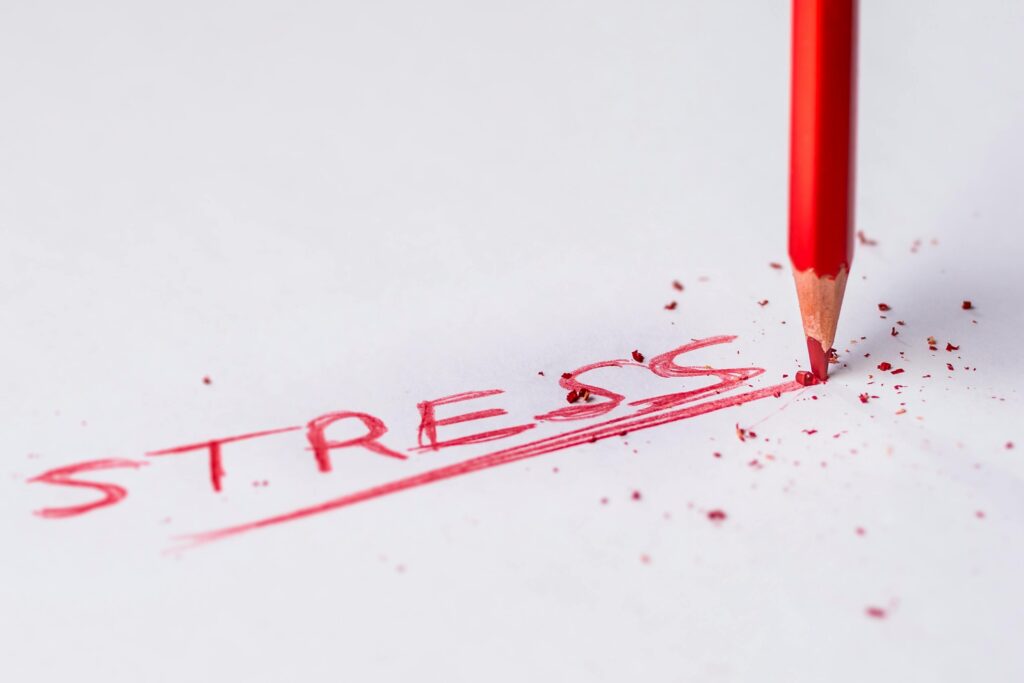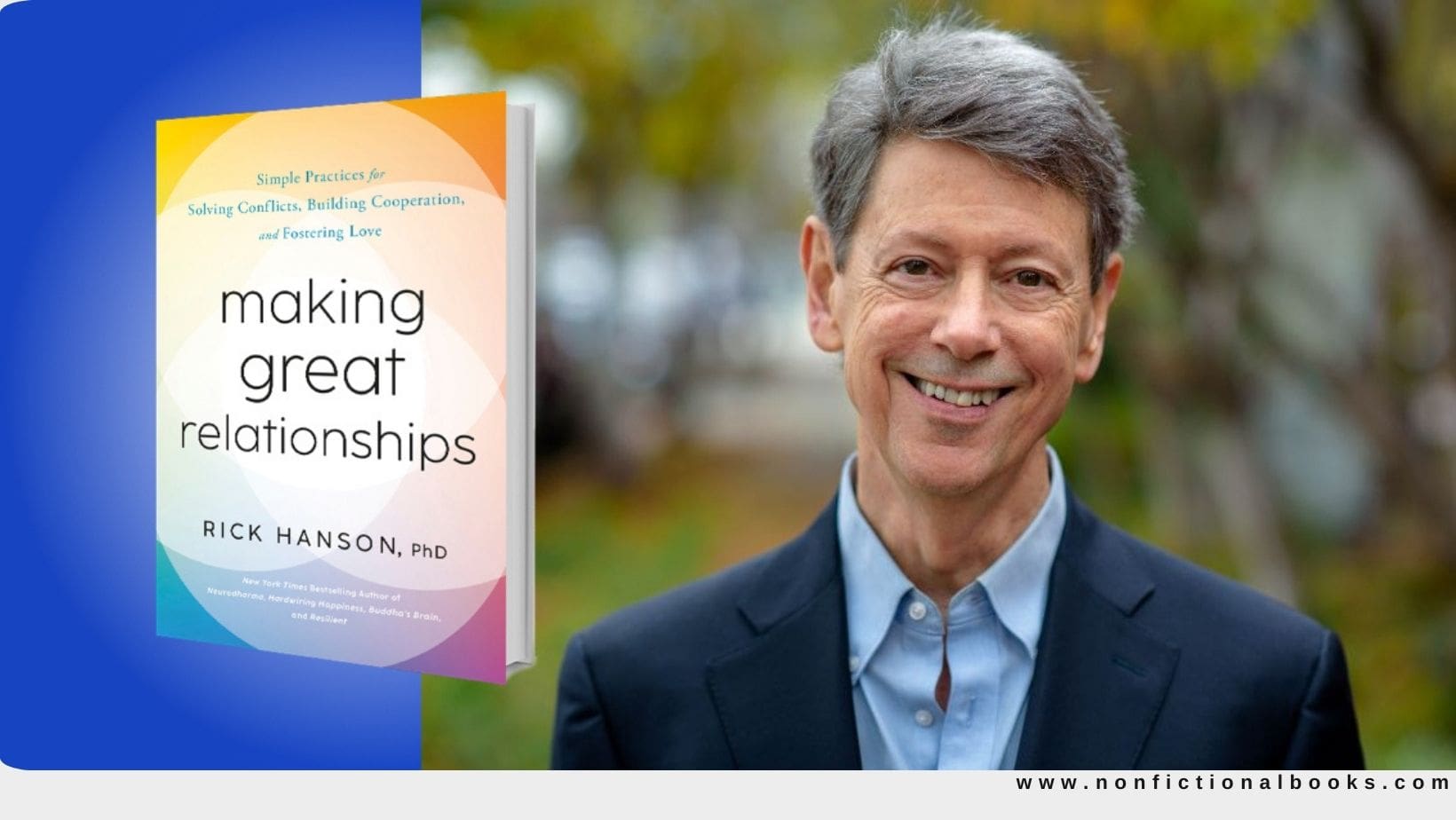Making Great Relationships Book Summary: Relationships are usually the most vital part of a person’s life. But they are often stressful and frustrating. And most are just strange, distant, and alone. We feel the burden of unspoken things, unfulfilled needs, and unresolved conflicts. It’s easy to feel stuck.
But in fact, new research shows that you create your relationships every day through the things you do and say, which allows you to start improving them right now. You have the power to improve all of your relationships by making simple changes, starting with yourself.
Rick Hanson brings his trademark warmth and clarity to Great Relationships, a comprehensive guide to fostering healthy relationships. Making Great Relationships starts at home and work, with family and friends, and with challenging people. In every field, Dr. Hanson has learned what causes relationships to break and what you can do to make them better.
Based on brain science and clinical psychology and inspired by contemplative wisdom, Making Great Relationships book summary offers fifty fundamental skills, including:
- How do you convince yourself that you deserve good treatment?
- How to Communicate Effectively in All Types of Settings
- How to stay focused so that conflict doesn’t bother you so deeply
- How to See the Good in Others (Even When They Make It Hard)
- How to set and maintain healthy boundaries or resize relationships as needed.
- How do you express your needs so they are more likely to be met?
With fifty practical yet powerful principles, you can deal with conflicts, show apparent compassion, behave better, deepen your romantic relationships, live with others peacefully, and reside in love in your heart. Exercising social skills will help you interact appropriately with people you usually spend time with and everyone you know.
Review: Making Great Relationships Book Summary
In his book “Simple Practices for Resolving Conflict, Building Relationships, and Fostering Love,” Rick Hanson creates a manual everyone who wants more understanding with people around them should read. Making Great Relationships Book Summary is for your healthy relationships and your bonding. It introduces a general approach to fitness, emphasizing essential tools and techniques that can be used in many different situations.
Hanson, an eminent psychologist and relationship guru, claims that developing satisfying relationships with others is the primary key to a happy life. He exclaims that healthy interpersonal connections are essential to physical and mental wellness, prosperity, and fulfillment. The book gives step-by-step details on how to develop and maintain relationships. It covers different areas, including communication, empathy, trust, and conflict resolution.
The book Making Great Relationships is presented in three different chapters. The initial section covers the pillars of effective relationships, such as knowing about yourself and others, the art of trusting, and the skill of being emotionally intelligent. The second part talks about how to establish and nurture intimacy and how, among others, communication skills, empathy, and comprehension are essential. The others form the third part, which contains practical tips and time strategies for resolving conflicts and issues effectively.
The Making Great Relationships Book Summary shows that self-awareness and self-reflection are the nouns that form the basis for all kinds of relationships. Hanson shows that the most significant attribute in forming sound relationships is understanding yourself and perceiving other people’s feelings. Determining ourselves helps us to find and express the particular emotions, goals, and beliefs that distinguish us as human beings, as well as to understand the feelings, desires, and beliefs of others, which is, in turn, a prerequisite for effective communication. The book allows readers to explore their hidden selves by enabling them to create self-designed reflections that clarify themselves and teach them about having insight into someone else.
Empathy is a central building block of relationships between people, making it a prominent characteristic of the story. Empathy helps, according to Hanson, as one of the main characteristics/critical building blocks of any relationship. With empathy, we can get acquainted and approach other people on an intense level. This literature discusses ways and strategies for creating goodness, like asking questions that make sense, staying calm instead of getting emotional, or listening constructively.
In the book, there is chapter 6, which is based on the fact that trust plays a significant role in relationships. Hanson is particular about trust, transparency, objectivity, and consistency.
Moreover, the person in an open relationship has transitioned into operating the role of conflict in relationships. The disputes, as she (Hanson) said, are just the best way of trying, but there is a way that love heals them. He gives specific guidelines for efficient methods of conflict resolution, such as utilizing the “I” statements, listening actively to others, and finding points of agreement.
In his book Making Great Relationships, Hanson is not just a theorist; he also shares his life experiences and case studies to help us visualize and understand the concepts and ideas he puts forth.
Making Great Relationships Book Summary: Strengths and weaknesses

Strength: Making Great Relationships Book Summary
Practical and actionable advice: It’s valuable and theoretical information that readers can use during their relationship processes to define how to deal with their relationships.
Broad Approach: Through the book, relationships together cover many of their facets, such as those of communication skills, empathy, trust, and conflict solving.
Real-life Examples: A practical approach presents real-life examples and scenarios on how to apply the learning.
Self-Reflection Exercises: The book offers helpful lessons and methods to view one’s perspective and experience one’s self and other people new and more deeply.
Weaknesses: Making Great Relationships Book Summary
Lack of depth: Some readers may find the book’s advice and strategies too basic or simplistic.
Too much focus on individual relationships:
Some would claim the book’s guidance and techniques are too simplistic. Too much focus on individual relationships: The writer emphasizes how personal relationships are handled instead of relations in general. (e.g., community, society).
Excerpts
Stay Right When You Are Wrong
Attacking another person out of anger is like throwing hot coals with bare hands: both sides of the flames are the victims. Use a soft voice with your heart; nothing but the truth should be afraid of it.
Let’s Go, Needless Fear
It is not part of our fault that we are unilaterally uneasy about all things. Nevertheless, we could – and must – take action.
Respect Your Needs
Many folks find expressing their needs clearly and openly difficult and shy. Nonetheless, the need to be filled is consistent; we all have it in common.
Building A Relationship
As love and romance go, their ups and downs are based on patience, dedication, and willingness to be flexible and move on with your partner. However, whether your relationship is simply starting or you have been together for years, there are some things you can do to place your relationship on a healthy road for the future. If you’ve been through plenty of unsuccessful relationships or have difficulty being close to your partner, there are always ways to stay in touch, be happy, and live a fulfilling life.

What makes a healthy relationship?
The fact that relationships are different and distinct in their way is well-known. People get together for various reasons. One of the factors that defines a healthy relationship is agreement on the same direction of what the relationship will be about and where it is going. The only way you’ll be able to acquire this knowledge is by engaging in conversation with your partner from more profound and authentic depths.
Yet, certain features of a healthy relationship differ from others. These guidelines help you keep the relationship in good shape and fulfilling, no matter your challenges and goals.
You can communicate with each other deeply and have a special connection on an emotional level. Both of you make each other happy and complete to the fullest. “Being loved” and “feeling loved” are very far apart. When our partner accepts us as we are and values us, it gives us the feeling of being loved! Partners in some relationships do not experience emotionally intense moments but maintain peaceful coexistence. While the relationship is going well, the longer a person is involved, the gap only increases if an individual doesn’t feel emotionally connected.
Sometimes, one can overhear people whispering to each other, and at different times, couples can quarrel loudly and passionately. Nevertheless, the main instrument for the success of any relationship does not reside in fear of conflicts. You have to permit yourself to voice your concerns without fear of retaliation, and the conflict has to be resolved without insulting, belittling, or trying to prove that you are right.
You stay in touch with your friends and have various entertainment options. Contrary to the advice from romantic movies or anything else, you will eventually only get some of your needs fulfilled. Expecting too much from your partner may lead to a dissatisfying relationship if you have different perspectives. To succeed in your romance, it is necessary to sustain your individuality outside the relationship, such as your relationships with family and friends and your various hobbies and interests.
Making Good Friends
When you and your partner understand what you want to achieve and feel comfortable sharing your concerns, wishes, and feelings, relationship trust grows, and you both become closer.
Falling in love vs staying in love
The comparison of falling in love and staying in love comes knocking on the door for most of us; no special recipe would help someone be in love. It’s not easy to have a loving relationship for so long or keep it at the “falling in love” level, which takes patience and work. Nevertheless, despite the cost, it is worth the while. One thing we all look for in a good relationship is unconditional support and constant happiness when needed the most, which is just one more plus for your mental health. A time-tested way to preserve those love feelings is to take the necessary steps now and create a lasting and meaningful relationship.
One of the common mistakes is that couples stress on their relationship when they need to solve some issues. They may return to their jobs, children, or other preoccupations after the problem is tackled. Nevertheless, the main characteristic of all kinds of romantic relationships is that they require participation and attention from both parties to grow. So, you must be ready to invest attention and effort to keep your romantic relationship healthy and alive. Solving and preventing a small apology in your relationship will be easy if you do it this way.
Tips For Building A Healthy Relationship
Whether trying to keep a new romantic relationship or repair a broken one, these tips from the Making Great Relationships book summary can help you feel loved and connected to your partner. The following tips can help you retain that feeling of love and keep your romantic relationship healthy.
Tip 1: Spend Some Time Face to Face
You fall in love by seeing and hearing each other. If you continue to look and listen with the same attention, you can keep the experience of falling in love intact for a long time. You probably have fond memories of the first time you were dating your loved one.
Everything seemed new and exciting, and you probably spent many hours talking together or coming up with new, exciting things to try. However, as time passes, it becomes harder to find time together due to the demands of work, family, and other obligations, and we all need time for ourselves.
Some couples find that the face-to-face contact of their early dating days has gradually been replaced by hurried texts, emails, and messages. Although digital communication is great for some purposes, it does not have the same positive effects on your brain and nervous system as face-to-face communication.
It’s great to send your partner a text or voice message saying “I love you,” but if you rarely look at them or even have time to sit together, they may feel that you don’t understand or appreciate them. And you will become more distant or separated as a couple.
The emotional signals you need to feel loved can only be expressed in person, so no matter how busy life gets, finding time to spend together is important. No matter how busy you are, take a few minutes daily to put away your electronic devices, stop thinking about other things, and focus on and connect with your partner.
Find something you enjoy doing together: a shared hobby, a dance class, a daily walk, or sitting down with a cup of coffee in the morning.
Try something new together. Doing new things together can be fun to connect and keep things interesting. This could be as simple as trying a new restaurant or going on a day trip somewhere you’ve never been.
Focus on having fun together. However, this playful attitude can sometimes be forgotten as life’s challenges get in the way or old resentments begin to fester. Maintaining a sense of humor can help you get through tough times, reduce stress, and deal with issues more easily. Think of fun ways to surprise your partner, like bringing flowers home or unexpectedly booking a table at their favorite restaurant. Playing with pets or small children can also help you reconnect with nature.
Work Together To Benefit Others
The most powerful way to stay close and connected is for you and your partner to jointly focus on something outside of the relationship that you value. Volunteering for a cause, project, or community work that has meaning for both of you can keep the relationship fresh and interesting. It can introduce you to new people and ideas, allow you to tackle new challenges together, and provide new ways to interact.
Along with helping to relieve stress, anxiety, and depression, working for the well-being of others brings immense happiness. A man is determined to help others. The more you help, the happier you will feel as an individual and as a couple.
Tip 2: Stay connected through communication
Good communication is a very important part of a healthy relationship. You feel secure and happy when you experience a positive emotional connection with your partner. When people stop communicating well, they stop relating, and times of change or stress can bring out isolation. This may seem simple, but as long as you are discussing it, you can usually solve all the problems you encounter.
Tell your partner what you need; don’t keep them guessing.
It’s not easy to talk about what you want. Many don’t spend enough time thinking about what’s important to them in a relationship. And even if you know what you want, talking about it can make you feel insecure, embarrassed, or ashamed. But look at it from your partner’s point of view. Providing comfort and understanding to the person you love is a pleasure, not a burden.
If you’ve known each other for a while, you can assume that your partner has a pretty good idea of your thoughts and needs. However, your partner is not a mind-reader. Although your partner may have some ideas, it is healthier to express your needs directly to avoid any confusion.
Your partner may understand some of it, but you may not need it. Furthermore, people change; for example, what you needed and wanted five years ago may be very different now. So, instead of letting resentment, misunderstanding, or anger build up when your partner consistently makes mistakes, tell them exactly what you need.
Pay attention to your partner’s nonverbal cues.
Most of our affection is revealed by what we don’t say. Nonverbal cues, including eye contact, tone of voice, posture, and gestures such as leaning forward, crossing your arms, or touching someone’s hand, communicate much more than words.
When you understand your partner’s nonverbal cues, or “body language,” you can tell how they feel and respond accordingly. If you want a relationship to work well, you must understand what you and your partner are saying, even if it is unspoken. Your partner’s reactions may differ from yours. For example, one person may find a hug a loving way to communicate after a stressful day, while another may simply want to walk or sit together and talk.
It’s also important to make sure what you say matches your body language. If you say, “I’m fine,” but you clench your teeth and look away, your body signals that you’re anything but “fine.”
When you experience positive emotional signals from your partner, you feel loved and happy, and when you send positive emotional signals back, your partner feels the same. When you stop taking an interest in your or your partner’s feelings, you will damage the relationship between you and them, especially when they are stressed about it.
Be A Good Listener
While our society places a lot of emphasis on talking, if you can learn to listen in a way that makes the other person feel valued and understood, you can create a deeper, stronger connection between you.
There is a big difference between listening in this way and simply listening. When you listen and are engaged in what is being said, you will hear the subtle tones in your partner’s voice that tell you how they are feeling and what emotions they are trying to convey. Being a good listener doesn’t mean you have to agree with your partner or change your mind. But it will help you find common approaches that can help you resolve the conflict.
Manage Stress
When stressed or emotionally overwhelmed, you may misunderstand your romantic partner, send confusing or unnatural nonverbal signals, or slip into unhealthy knee-jerk behavior patterns. How often have you been stressed and angry at your loved one and said or done something you later regretted?
If you can learn to manage stress and return to a calm state quickly, you will not only avoid such regrets but also help avoid conflicts and misunderstandings – and even help calm your partner when anger rises.

Tip 3: Keep physical intimacy alive
Touch is a fundamental part of human existence. Studies in infants have shown the importance of regular, affectionate contact for brain development. And the benefits don’t end in childhood. Affectionate contact increases oxytocin levels in the body, a hormone that affects bonding and attachment.
Sex is often the cornerstone of a committed relationship. This can be a great way to protect or improve mental, physical, and emotional health. However, many couples find it difficult to talk about sex, especially when there are sexual problems. Feelings of embarrassment, shame, and hurt can often affect physical intimacy and drive you apart.
No matter what problems you’re facing, there are plenty of options you can take to improve and make your sexual life better. For example, an issue like erectile dysfunction can be a difficult topic to discuss. But there are solutions available, including medications.
It’s also important to remember that sex shouldn’t be the only form of physical intimacy in your relationship.
It’s important to be aware of what your partner likes. It’s your responsibility. Unwanted touching or inappropriate behaviour can cause the other person to become stressed and withdrawn—exactly what you don’t want. Like many other aspects of a healthy relationship, it depends on how well you communicate your needs and intentions with your partner.
Even if you have work pressures or small children to worry about, you can help keep physical intimacy alive by setting aside some regular couple time, whether in the form of date night or at the end of the day. I just have an hour when you can sit and talk or hold hands.
Conclusion
Looking to strengthen your bonds with friends, family, and loved ones? Check out “Making Great Relationships Book Summary” on Non-Fictional Books. This website dives into the key takeaways from many nonfiction books.
Intrigued? Learn more and discover 87 powerful quotes from the book by visiting the full summary here Making Great Relationships Quotes

